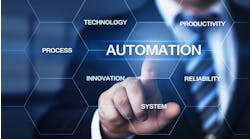The transformative potential of digitalization
Smart Industry: What industries/businesses are best-positioned to take full advantage of digitalization? Which already are?
Helmuth: Relentless innovation fueled by technology and connectivity is driving a digital revolution that will disrupt and transform entire industries. All industries are experiencing the impact of digitalization.
Discrete manufacturing and process industries are in an excellent position to take full advantage of digitalization to transform their business.
Smart Industry: Where are we at, globally, in terms of realizing the transformative potential of digitalization?
Helmuth: According to the PWC 2016 Global Industry 4.0 survey:
- Over the next five years companies surveyed expect annual revenue increases by an average of 2.9% and reduced cost by an average of 3.6%
- Global industrial products manufacturers will invest $907 billion per year through 2020 in Industry 4.0 investments
- In five years, more than 80% of companies will have digitalized their value chain
- “First movers” are already making the shift and using data-analytics to help drive decision-making
In realizing the economic importance of manufacturing and that the disruption and transformation that will happen, Siemens continues to participate in public/private partnerships, such as Industry 4.0, DMDII, CCAM and the Industrial Internet Consortium. The strategy is to develop a forward-looking roadmap which prepares manufacturing industry for digitalization. These public/private partnerships will enable manufacturers to transform their business into a digital enterprise in order to compete. They will also encourage new businesses to enter the digital economy.
Our Digital Enterprise Software Suite provides the technical foundation for the digital enterprise and our customers’ digital enterprise. Our software portfolio creates a digital thread that intelligently connects smart virtual models (digital twins) and real-time production information across lifecycle phases of ideation, realization and utilization, and across value-chain participants, to form a smart innovation environment.
Smart Industry: What is the greatest power of digitalization?
Helmuth: Through digitalization, manufacturers have greater flexibility to adapt to changing business opportunities caused by digital disruption. Only a fully digitalized business model with a consistent digital thread has the power to speed up and optimize processes to drive innovation.
Digitalization also creates new business opportunities in product and asset utilization. The key difference that the industrial Internet makes is that it brings machinery alive through the IIoT. It brings sensing and communicating capabilities to places where they’re not expected to be found. This enables the machinery to sense its own condition, understand the usage situation and support the user to carry out the operation more safely and productively. This information creates new opportunities for service and support business models.
Smart Industry: What examples of cyber-physical systems most excite you?
Helmuth: Autonomous vehicles. This digital-industrial revolution will be characterized by intelligent, autonomous machine behavior. The best example of this today are autonomous vehicles. Google has had autonomous vehicles on the road for years in the Silicon Valley and in Austin, TX. Google is the furthest along in exploring the impact of AI decision-making, as are the automotive OEMS that have active autonomous-vehicle programs in place.
Spider bots (SiSpis). The next step in 3D printing could be something called mobile manufacturing. Siemens researchers in Princeton, New Jersey have developed prototype spider-like robots that can work collaboratively to print structures and surfaces, thus potentially accelerating production of large-scale, complex structures such as the fuselages of planes and the hulls of ships.
The digital factory. Siemens and Local Motors have formed a new partnership which is intended to help advance the future of manufacturing by optimizing the development and large-scale 3D printing of cars. The partnership combines the power of Siemens' product lifecycle management (PLM) software technology with Local Motors' leadership in co-created and 3D-printed vehicles--a process called direct digital manufacturing (DDM). With a shared vision for the future of product development, Local Motors plans to enhance productivity in its innovative Local Motors (LM) Labs program by leveraging Siemens' expertise in creating "digital twins," while Siemens expects to further enhance its digital-enterprise software suite to support the latest advances in additive manufacturing and 3D printing.
Smart Industry: Why is it critical that this process takes place before prototypes are built/before a plant is even built?
Helmuth: The digital twin is an accurate virtual representation of the product and its manufacturing processes to predict and optimize performance in the physical world. The greater the accuracy, the greater the value in predicting performance. The digital twin of the product reduces the need for physical prototypes. The digital twin of the plant and production process minimizes production downtime and improves first-pass yield.




